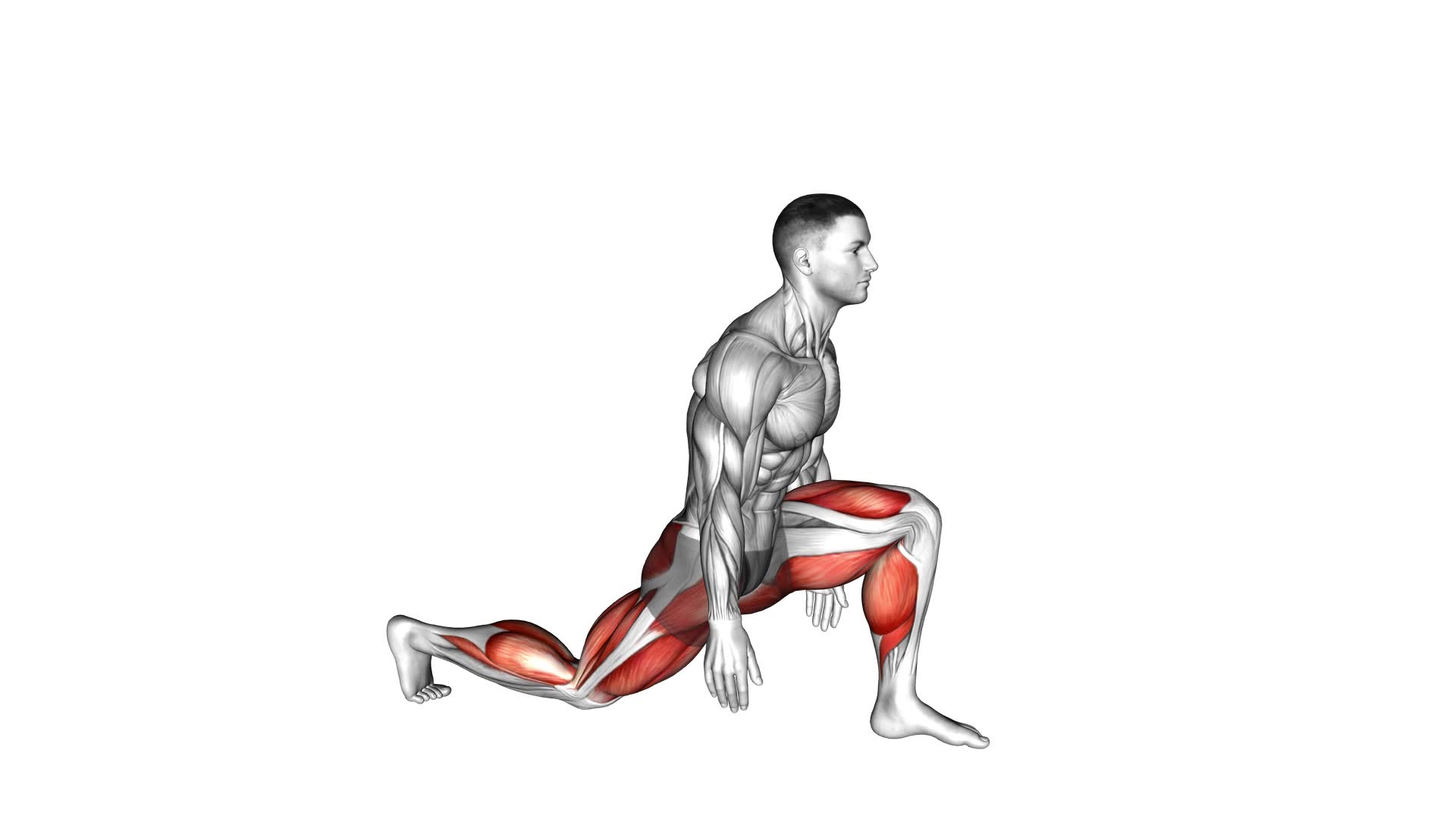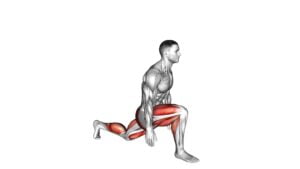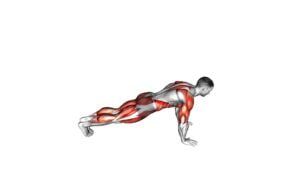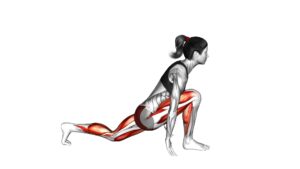Low Lunge (male) – Video Exercise Guide & Tips

Looking to improve your workout routine? Check out our video exercise guide and tips for the low lunge specifically tailored for men.
Watch This Exercise Video
This dynamic exercise offers numerous benefits, from strengthening your lower body to improving flexibility. Learn the proper form and technique to maximize your results and avoid common mistakes.
With modifications and variations available, you can customize the low lunge to your fitness level.
Enhance your workout and incorporate the low lunge into your fitness routine today.
Key Takeaways
- The low lunge strengthens lower body muscles such as quads, hamstrings, glutes, and hip flexors.
- It improves flexibility in hip flexors and increases range of motion in the hips.
- The low lunge enhances athletic performance and reduces the risk of injuries.
- Proper form and technique, such as maintaining an aligned back and engaged core, are crucial for performing the low lunge correctly.
Benefits of the Low Lunge for Men
Experience the many benefits of the Low Lunge, a powerful exercise that targets and strengthens the lower body muscles in men. Incorporating the Low Lunge into your workout routine can lead to significant improvements in flexibility and the strengthening of your lower body muscles. This exercise primarily focuses on your quads, hamstrings, glutes, and hip flexors, helping you develop stronger and more toned legs and buttocks.
By performing the Low Lunge regularly, you'll notice increased flexibility in your hip flexors and improved range of motion in your hips. This can be especially beneficial for men who participate in sports that require quick and explosive movements, such as basketball or soccer. Strengthening your lower body muscles through the Low Lunge can also enhance your overall athletic performance and reduce the risk of injuries.
Furthermore, the Low Lunge engages your core muscles, promoting stability and balance. It also activates your calf muscles, which can contribute to improved lower body strength and endurance. Incorporating variations of the Low Lunge, such as adding weights or performing lunges with a twist, can further challenge your muscles and provide additional benefits.
To ensure you get the most out of the Low Lunge, it's essential to maintain proper form and technique. Transitioning into the subsequent section, let's explore the correct way to perform this exercise for maximum effectiveness and safety.
Proper Form and Technique for the Low Lunge
To ensure you get the most out of the Low Lunge and maximize its effectiveness and safety, it's important to focus on proper form and technique. Here are some key points to keep in mind:
- Low Lunge Alignment:
- Start by standing with your feet hip-width apart.
- Step your right foot forward, keeping your knee directly above your ankle.
- Lower your left knee to the ground, with your toes tucked under for support.
- Keep your back straight and aligned with your hips.
- Engage your core to maintain stability throughout the exercise.
- Low Lunge Modifications:
- If you have knee pain or discomfort, you can place a blanket or cushion under your back knee for support.
- To increase the intensity, you can add a twist by placing your left hand on your right knee and reaching your right arm up towards the ceiling.
- For an extra challenge, you can lift your back knee off the ground and come into a high lunge position.
Remember to listen to your body and make any necessary modifications to ensure proper alignment and prevent injury. By practicing proper form and technique, you'll be able to reap the full benefits of the Low Lunge exercise.
Common Mistakes to Avoid During the Low Lunge
Correct alignment is crucial to avoid common mistakes in the Low Lunge exercise. Maintaining proper form ensures that you get the most out of this exercise and prevent any potential injuries.
One common mistake to avoid is leaning too far forward. This can put excessive strain on your front knee and increase the risk of injury. Instead, focus on keeping your torso upright and aligned with your hips.
Another mistake to watch out for is allowing your front knee to collapse inward. This can put stress on your knee joint and lead to pain or discomfort. To prevent this, make sure to keep your front knee in line with your ankle, creating a 90-degree angle.
Lastly, avoid arching your lower back excessively. This can strain your lower back muscles and compromise your form. Engage your core muscles and maintain a neutral spine throughout the exercise.
Modifications and Variations for the Low Lunge
To modify or vary the Low Lunge exercise, you can incorporate different props or adjust the depth of the lunge. Here are some low lunge modifications and advanced low lunge variations to add variety and challenge to your workout:
- Modifications:
- Use yoga blocks: Place yoga blocks under your hands to provide support and stability, especially if you have limited flexibility.
- Use a wall: Stand facing a wall and place your hands on it for balance and support. This will help you maintain proper form and prevent strain on your joints.
- Advanced Variations:
- Twisted low lunge: From the low lunge position, twist your torso towards the front leg, reaching your opposite arm towards the ceiling. This variation increases spinal mobility and engages the oblique muscles.
- Low lunge pulses: While in the low lunge position, perform small up and down movements with your hips. This variation targets the quads and glutes, adding an extra challenge to the exercise.
Tips to Enhance Your Low Lunge Workout
Maximize your low lunge workout by implementing these helpful tips. Low lunge modifications can help you customize the exercise to your fitness level and flexibility. If you have limited flexibility, you can place your hands on blocks or use a yoga strap to support your balance and maintain proper alignment. This modification allows you to deepen the stretch without straining your muscles. Additionally, you can elevate your back foot on a block to increase the intensity of the stretch and engage your leg muscles even more.
The low lunge offers numerous benefits for flexibility. By stretching your hip flexors, quads, and hamstrings, you can improve your range of motion and prevent muscle imbalances. This exercise also helps to open up your hips and increase hip mobility, which is especially beneficial for athletes and those who sit for long periods. By incorporating the low lunge into your regular fitness routine, you can enhance your overall flexibility and improve your performance in other exercises.
Now that you have learned some helpful tips to enhance your low lunge workout, let's explore how to incorporate the low lunge into your fitness routine.
How to Incorporate the Low Lunge Into Your Fitness Routine
To incorporate the low lunge into your fitness routine, start by warming up your body with a few minutes of dynamic stretches and cardio exercises. This will help prepare your muscles and joints for the movements involved in the low lunge.
Once you're warmed up, you can incorporate the low lunge into your strength training routine. Here's how you can do it:
- Low lunge as a standalone exercise: Perform multiple sets of low lunges on each leg, focusing on proper form and control. This will help improve lower body strength, particularly in the quadriceps, hamstrings, and glutes.
- Low lunge in a circuit: Include the low lunge in a circuit training routine by combining it with other exercises such as squats, push-ups, or planks. This will add variety to your workout and challenge your muscles in different ways.
When it comes to flexibility, the low lunge is a great option. However, if you're specifically looking to improve flexibility, the high lunge may be more beneficial. The high lunge targets the hip flexors and promotes deeper stretching in the front of the hip and thigh.
Consider incorporating both low lunges and high lunges into your routine to reap the benefits of both strength training and flexibility improvement.
Frequently Asked Questions
How Many Calories Does the Low Lunge Exercise Burn?
The low lunge exercise is great for burning calories and toning your lower body. It targets your quads, glutes, and hamstrings, helping to strengthen and shape those muscles.
Adding modifications like holding weights or incorporating jumps can increase the calorie burn. While the exact number of calories burned during the low lunge exercise depends on factors like intensity and body weight, it's generally considered a high-intensity exercise that can help you reach your calorie-burning goals.
Can I Perform the Low Lunge Exercise if I Have Knee Pain?
If you have knee pain, it's important to listen to your body and avoid exercises that aggravate the pain. The low lunge exercise may not be suitable for you in this case.
However, there are modifications you can make to the low lunge or alternative exercises that can help alleviate knee pain.
It's always best to consult with a healthcare professional or a certified fitness trainer for personalized advice and recommendations.
Is It Better to Perform the Low Lunge Exercise With or Without Weights?
When performing low lunge variations, you might wonder if it's better to do them with or without weights.
Well, incorporating weights into your low lunge exercise can provide additional benefits. Adding weights can help increase resistance, build strength in your lower body, and enhance overall muscle tone.
However, it's important to start with lighter weights and gradually increase as you get stronger. Consult with a fitness professional to ensure you're using proper form and technique to prevent any potential injuries.
How Long Should I Hold the Low Lunge Stretch?
To get the most out of the low lunge stretch, it's important to know how long to hold it. The recommended duration is around 30 seconds to a minute on each side. This allows your muscles to fully stretch and improve flexibility.
Beginners can modify the low lunge by using a block or resting their hands on their thigh for support.
Incorporating this stretch into your daily routine has many benefits, including improved hip flexibility and increased lower body strength.
Can the Low Lunge Exercise Help Improve My Balance and Stability?
The low lunge exercise is great for improving your balance and stability. By incorporating this exercise into your routine, you can strengthen your lower body muscles and enhance your overall stability.
Additionally, the low lunge allows for variations, such as adding a twist or incorporating weights, which can further challenge your balance and stability.
Conclusion
Incorporating the low lunge into your fitness routine can provide numerous benefits for men, such as improved flexibility, increased strength, and enhanced balance.
By practicing proper form and technique, avoiding common mistakes, and exploring modifications and variations, you can maximize the effectiveness of this exercise.
Remember to listen to your body, focus on breathing, and gradually increase the intensity to achieve optimal results.
Start incorporating the low lunge into your workouts and experience the positive impact it can have on your overall fitness journey.

Author
Years ago, the spark of my life’s passion ignited in my mind the moment I stepped into the local gym for the first time. The inaugural bead of perspiration, the initial endeavor, the very first surge of endorphins, and a sense of pride that washed over me post-workout marked the beginning of my deep-seated interest in strength sports, fitness, and sports nutrition. This very curiosity blossomed rapidly into a profound fascination, propelling me to earn a Master’s degree in Physical Education from the Academy of Physical Education in Krakow, followed by a Sports Manager diploma from the Jagiellonian University. My journey of growth led me to gain more specialized qualifications, such as being a certified personal trainer with a focus on sports dietetics, a lifeguard, and an instructor for wellness and corrective gymnastics. Theoretical knowledge paired seamlessly with practical experience, reinforcing my belief that the transformation of individuals under my guidance was also a reflection of my personal growth. This belief holds true even today. Each day, I strive to push the boundaries and explore new realms. These realms gently elevate me to greater heights. The unique combination of passion for my field and the continuous quest for growth fuels my drive to break new ground.







